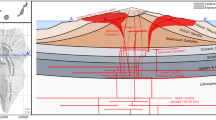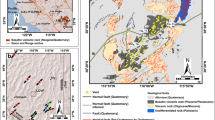Abstract
A new method for obtaining from volcanic surface features the orientations of the principal tectonic stresses is applied to Aleutian and Alaskan volcanoes. The underlying concept for this method is that flank eruptions for polygenetic volcanoes can be regarded as the result of a large-scale natural magmafracturing experiment. The method essentially relies on the recognition of the preferred orientation of radial and parallel dike swarms, primarily using the distribution of monogenetic craters including flank volcanoes. Since dikes tend to propagate in a direction normal to the minimum principal stress (T-axis), the method primarily yields the direction of the maximum horizontal compression (MHC) of regional origin. The direction of the MHC may correspond to either the maximum (P-axis) or intermediate (B-axis) principal stress.
The direction of MHC obtained at 20 volcanoes in the Aleutian arc coincides well with the direction of convergence between the Pacific and North American plates. This result provides evidence that in the island arc the inferred direction of MHC is parallel to the maximum principal tectonic stress. In the back-arc region, general E-W trends of MHC are obtained from seven volcanic fields on islands on the Bering Sea shelf and the mainland coast of Alaska. These volcanic fields consist mostly of clusters of monogenetic volcanoes of alkali basalt. In the back-arc region, the trends of MHC may correspond to an E-W intermediate, a vertical maximum, and a N-S minimum principal stress.
Implications for the tectonics of island arcs and back-arc regions are: (1) volcanic belts of some island arcs, including the Aleutian arc, are under compressional deviatoric stress in the direction of plate convergence. It is improbable that such arcs would split along the volcanic axis to form actively spreading marginal basins. (2) This compressional stress at the arc, probably generated by underthrusting, appears to be transmitted across the entire arc structure, but is apparently replaced within several hundred kilometers by a stress system characterized by horizontal extension (tensional deviatoric stress) in the back-arc region. (3) The volcanoes associated with these two stress systems differ in type (polygenetic vs. monogenetic) and in the chemistry of their magmas (andesitic vs. basaltic). These differences and the regional differences in orientation of the principal tectonic stresses suggest that the back-arc stress system has its own source at considerable depth beneath the crust.
Similar content being viewed by others
References
Brogan, G. E., Cluff, L. S., Korringa, M. K. andSlemmons, D. B. (1975),Active faults of Alaska, Tectonophysics29, 73–85.
Burk, C. A. (1965),Geology of the Alaska Peninsula, Part 2: geological map Geol. Soc. Amer. Mem.99.
Byers, F. M., Jr. (1959),Geology of Umnak and Bogoslof Islands Aleutian Islands, Alaska, US Geol. Surv. Bull.1028-L: 267–369.
Byers, F. M. andBarth, T. F. W. (1949),Volcanic activity on Akun and Akutan Islands, Proc. 7th Pacific Sci. Congr. New Zealand2, 382–397.
Coats, R. R. (1953),Geology of Buldir Island, Aleutian Islands, Alaska, US Geol. Surv. Bull.989-A, 8–9.
Coats, R. R. (1956),Geology of northern Adak Island, Alaska, US Geol. Surv. Bull.1028-C, 47–67.
Coats, R. R. (1959),Geologic reconnaissance of Gareloi Island, Aleutian Islands, Alaska, US Geol. Surv. Bull.1028-J, 249–256.
Coats, R. R. (1964),Aleutian islands and Alaska, Bull. Volc. Eruptions4, 4–5.
Coats, R. R., Nelson, W. H., Lewis, R. Q. andPowers, H. A. (1961),Geologic reconnaissance of Kiska Island, Aleutian Islands, Alaska, US Geol. Surv. Bull.1028-R, 563–581.
Coonrad, W. L. (1957),Geologic reconnaissance in the Yukon-Kuskokwin Delta region, Alaska. US Geol. Surv. Misc. Geol. Investigations Map, I-223, 1∶500,000.
Cox, A., Hopkins, D. M. andDalrymple, G. B. (1966),Geomagnetic polarity epochs: Pribilof Islands, Alaska, Geol. Soc. Amer. Bull.77, 883–910.
Detterman, R. L., Plafker, G., Hudson, T., Tysdal, R. G. andPavoni, N. (1974),Surface geology and Holocene breaks along the Sustina segment of the Castle Mountain fault, Alaska, US Geol. Surv. Misc. Field Studies, Map MF 618.
Drewes, H., Fraser, G. D., Snyder, G. L. andBarnet, H. F., Jr. (1961),Geology of Unalaska Island and adjacent insular shelf, Aleutian Islands, Alaska, US Geol. Surv. Bull.1028-S, 583–676.
Foster, H. L., Forbes, R. B. andRagen, D. M. (1966),Granulite and peridotite inclusions from Prindle volcano, Yukon-Tanana upland, Alaska, US Geol. Surv. Prof. Paper550-B, 115–119.
Grantz, A., Zietz, I. andAndreasen, G. E. (1963).An aero-magnetic reconnaissance of the Cook Inlet area, Alaska, US Geol. Surv. Prof. Paper316-G, 117–134.
Hoare, J. M. andCondon, W. H. (1971a),Geologic map of the St. Michael quadrangle, Alaska, US Geol. Surv. Misc. Geol. Investigations Map I-682.
Hoare, J. M. andCondon, W. H. (1971b),Geologic map of the Marshall quadrangle, western Alaska, US Geol. Surv. Misc Geol. Investigations Map I-668.
Hoare, J. M., Cox, A., Dalrymple, G. B. andCondon, W. H. (1968),Geology, paleomagnetism and potassium-argon ages of volcanic rocks, Nunivak Island, Alaska, Geol. Soc. Amer Mem.116, 377–413.
Hopkins, D. M. (1963),Geology of the Imuruk Lake area Seward Peninsula, Alaska, US Geol. Surv. Bull.1141-C, 1–101.
Jacob, K. H., Nakamura, K. andDavies, J. N. (1977),Trench-volcano gap along the Alaska-Aleutian arc: Facts, and speculations on the role of terrigenous sediments for subduction, AGU Monogr., Ewing Symposium on Island Arcs and Back-arc Regions., in press.
Juhle, W. andCoulter, H. (1955),The Mt. Spurr eruption, July 9, 1953, Trans. Amer. Geophys. Union36, 199–202.
Karig, D. E. (1974),Evolution of arc systems in the western Pacific, Ann. Rev. Earth Planet. Sci.2, 51–75.
Kennedy, G. C. andWaldron, H. H. (1955),Geology of Pavlof volcano and vicinity, Alaska, US Geol. Surv. Bull.1028-A, 1–19.
Lensen, G. J. (1961),Principal horizontal stress directions as an aid to the study of crustal deformation, Publ. Dom. Obs. Ottawa49, 389–397.
Lensen, G. J. andOtway, P. M. (1971),Earthshift and post-earthshift deformation associated with the May 1968 Inangahua earthquake, New Zealand, Roy. Soc. New Zealand Bull.9, 107–116.
Loney, R. A., Brew, D. A., Muffler, L. J. P. andPomeroy, J. S. (1975),Reconnaissance geology of Chichagof, Baranof, and Kruzof Islands, southern Alaska, US Geol. Surv. Prof. Paper792, 1–105.
Moore, J. G., Nakamura, K. andAlcaraz, A. (1966),The 1965 eruption of Taal volcano, Science151, 955–960.
Nakamura, K. (1969),Arrangement of parasitic cones as a possible key to regional stress field, Bull. Volc. Soc. Japan14, 8–20 (in Japanese with English abstract).
Nakamura, K. (1977),Volcanoes as possible indicators of tectonic stress orientation: Principle and proposal, J. Volc. Geoth. Res. 2, in press.
Nelson, W. H. (1959),Geology of Segula, Davidof and Khvostof Islands, Alaska, US Geol. Surv. Bull.1028-K, 257–266.
Pavoni, N. (1971),Recent and late Cenozoic movements of the earth's crust, Roy. Soc. New Zealand Bull.9, 7–17.
Richardson, R. M., Solomon, S. C. andSleep, N. H. (1976),Intraplate stress as an indicator of plate tectonic driving force, J. Geophys. Res.81, 1847–1856.
Simons, F. S. andMathewson, D. E. (1955),Geology of Great Sitkin Island, Alaska, US Geol. Surv. Bull.1028-B, 21–43.
Smith, R. L. andSoule, C. E.,Western Alaska and Bering Sea Islands; Alaska Peninsula and the Aleutian Islands and Range inData Sheets of the Post-Miocene volcanoes of the world with index maps (IAVCEI, Rome 1973).
Snyder, G. L. (1959),Geology of Little Sitkin Island, Alaska, US Geol. Surv. Bull.1028-H, 169–210.
Sykes, L. R. andSbar, M. L.,Focal mechanism solutions of intra-plate earthquakes and stresses in the lithosphere inGeodynamics of Iceland and the North Atlantic Area, (ed. Kjartansson), 207–224.
Yoder, H. S.,Generation of Basaltic Magma (National Academy of Sciences, Washington, D.C. 1976), 265 pp.
Author information
Authors and Affiliations
Additional information
Lamont-Doherty Geological Observatory Contribution No. 2503.
Rights and permissions
About this article
Cite this article
Nakamura, K., Jacob, K.H. & Davies, J.N. Volcanoes as possible indicators of tectonic stress orientation — Aleutians and Alaska. PAGEOPH 115, 87–112 (1977). https://doi.org/10.1007/BF01637099
Received:
Issue Date:
DOI: https://doi.org/10.1007/BF01637099




